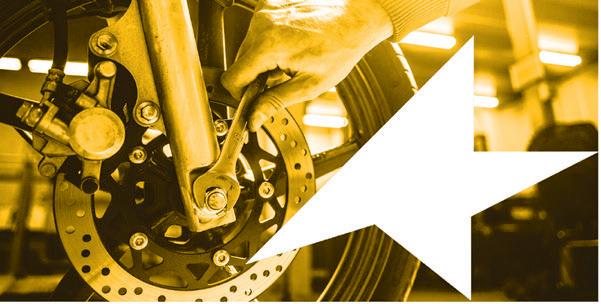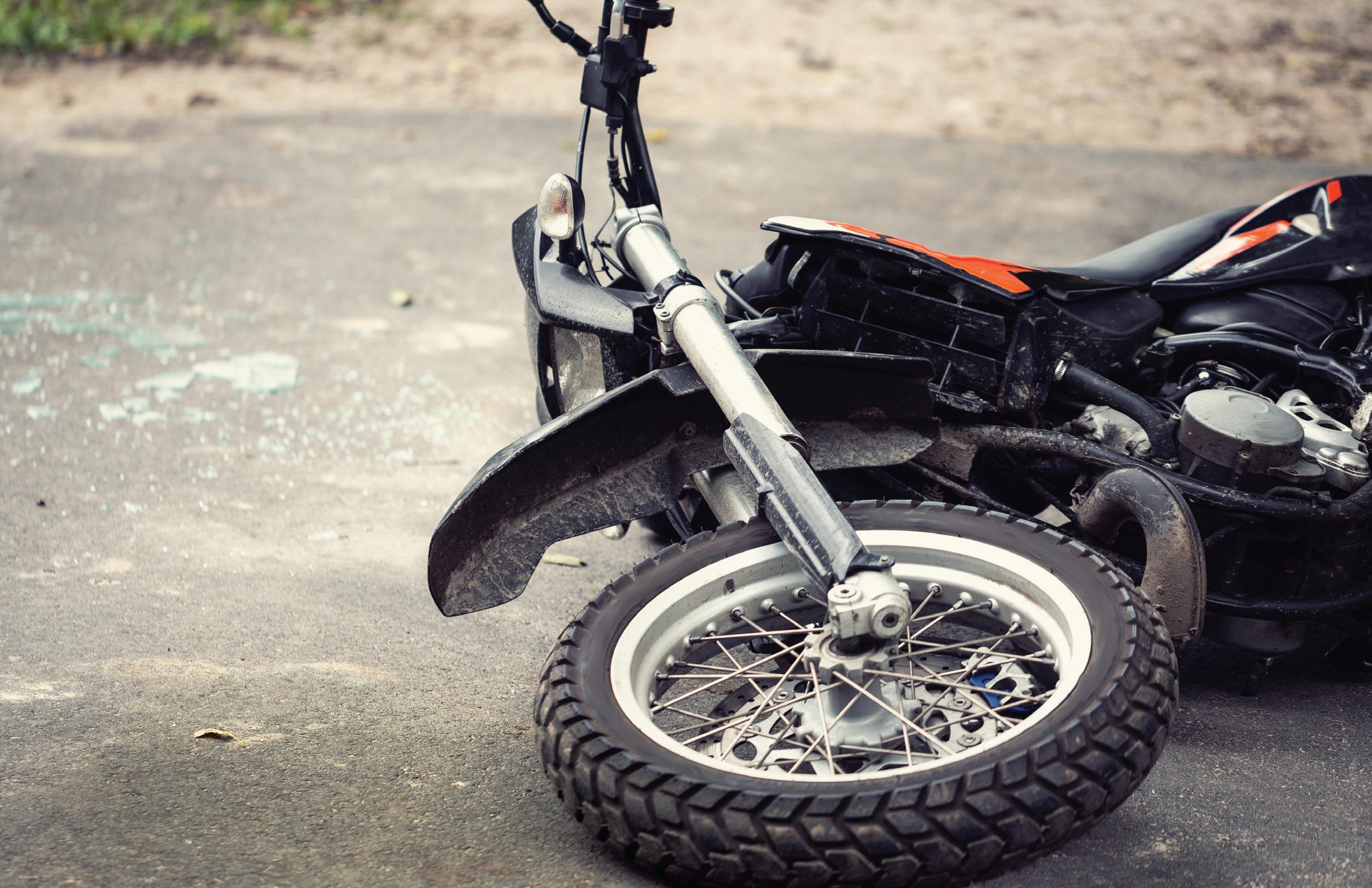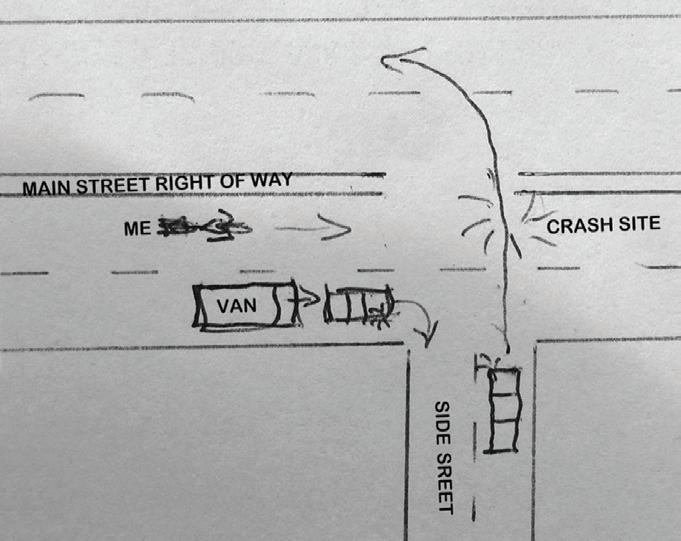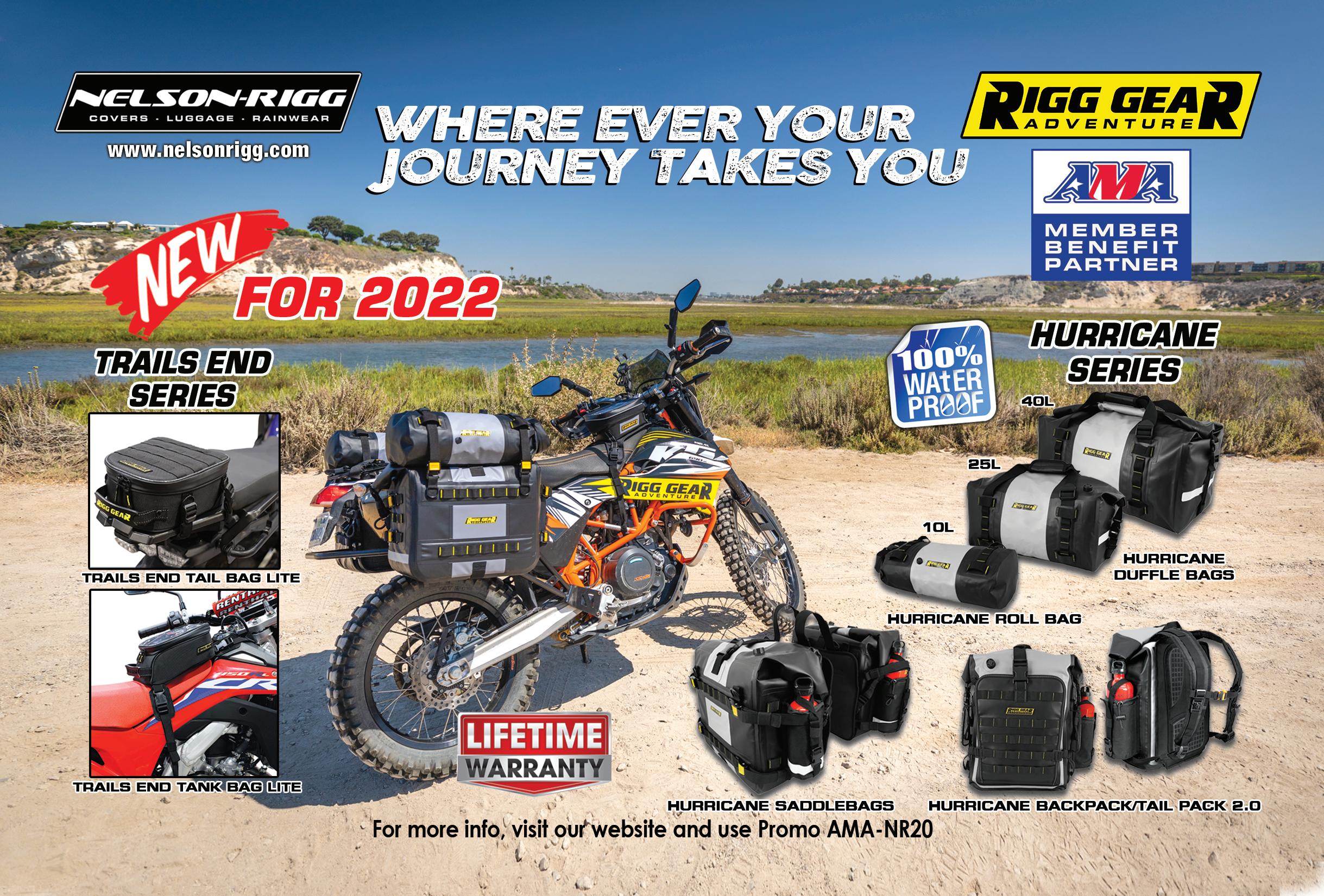
10 minute read
AMA GARAGE
Tips,Tweaks, Fixes and Facts: The two-wheeled ownership experience, explained
STREET SAVVY TALES OF THE TUMBLE

AMA members and enthusiasts recount their first spills…and what they learned from them
Amonth or so ago our intrepid social media maven Joy Burgess tossed out the following
question on our social media channels: Tell us about your first tip-over or crash. What happened, and what did you learn? The response has been energetic, with both funny and informative tales adding up like Vince Friese holeshots. And since May is Motorcycle Safety Awareness Month, we figured we’d share some to help keep you off the ground — or at least make you smile. So enjoy!
It was 15 feet from the start of my first motorcycle ride. I kept stalling it, so I gave it full wrist and dumped the clutch. Lesson: friction is actually a thing!
Matt James
I was riding in the riverbed and something in the sand stopped my front end faster than the back end, which caused the latter to go over the top of the former. I was grateful I was wearing a helmet, but the rubbing alcohol and Merthiolate bath I got when I got home was worse than the get-off!
Mike Hendershot
That last part might just be TMI, Mike! —Ed
When I was sixteen in 1971 I’d been riding my Honda SL125 for six months and had just replaced the worn “universal” knobbies with more dirt-oriented ones. I was riding to school one morning and while turning a street corner with a little dew on the pavement I quickly found out that tires designed to grab mud weren’t very good at grabbing slippery pavement. Just a little skin left on the road, but a quick lesson learned.
Bob Haddon
Thanks for the good general reminder about tires, Bob. Whether they’re just new (that mold-release stuff is slippery!) or the wrong tire for the environment (knobbies on pavement? C’mon!), new tires can definitely be tricky. —Ed.
Riding enduros as I do, I rarely have a day where the bike doesn’t end up on its side at least once. Just the nature of the beast. I’ve been down multiple times on the street, too, and each time I’ve crashed on asphalt it was preventable by slowing down. Just happens when you push things to the limit.
Nathan Sours
Well, what have you learned (or not learned!), Nathan?!—Ed
I stopped to get some gas. I thought the kickstand was down…but it wasn’t…
John Feldt
I had my Road King 22 years before it finally fell over when I was backing up in the sand! BTW, it still has the original paint, 34 years in May! Over 50 years and never a serious accident. I’m very blessed!
John Brewer
There have been a few on dirt and street over the years. The lesson is always ATGATT.
It doesn’t make you invincible by any means, but wearing the right gear can be the difference between standing up and brushing yourself off or a ride in an ambulance.

Adam Pierce
Can’t stress this enough, Adam, so thanks for the reminder. —Ed
First time a bee went up my shorts at 60 mph was the last time I wore shorts on my 1983 CB1100F.
Joe Stanton
Why do we feel you’ve left out some important details, Joe?! C’mon…ya gotta spill! —Ed.
Honda 50, about seven years old. Tearing down the back trail and hit a rut going perpendicular to trail. First introduction to the “over the bars” club.
Rusty Fenders
My first three crashes were caused by cars around me, and I collected from their insurance. The first crash that was completely my fault happened on a highway in the Texas hill country, at night, in stormy weather. I crested a hill and there was an accident site in the road in front of me. I grabbed the front brake too hard and low-sided. Plain old speed — riding too fast for the conditions.
Mark Hunter
More great advice, Mark. Thanks for sharing.—Ed
Gravel is hard to see at night in poorly-lit intersections. I learned this the hard way.
Mitch Manthey
This little sketch explains my crash in 1996. The car coming out of the side street didn’t see me because of the van. Was his fault, and he also stopped in my lane because of traffic coming from his right before he was able to turn left.
KEVIN WING
Cobra H Rhod
A drunk bartender ran a stop sign and hit me head on. I went over the top of the Corvair, the bike went underneath it, and he continued on for a full city block. My then-new Bell helmet saved my life, as I landed on my head. Only problem was, my foot went thru a headlight when I hit the car, and I was wearing sandals. Quite a job removing the glass!
Jan Kaftanski
What’s that Nancy Sinatra lyric? “These boots are meant for ridin’.” —Ed

Garage Gear Basics & ATGATT
If you fall, and you likely will at some point, it’s way better with the right gear. Trust us on this.
BY MITCH BOEHM
Igrew up reading motorcycle magazines and idolizing
the racers and road testers in those pages, so the idea of riding without proper gear was, to me, very definitely uncool.
Obviously, some riders don’t see things that way, and whether it’s because of perceived discomfort, a lack of socalled “coolness,” restrictions on their liberty or whatever, they are risking plenty with the choice. Just ask someone who’s been down without; they’ll tell you — if they can still speak, that is.
Having crashed at speed on the racetrack and on the street, I know firsthand what it feels like to slide and tumble while wearing proper gear. And in most of those cases, I popped right up, sore and bruised, maybe, but reasonably intact — which is what you want when you go down.
With the month of May being Motorcycle Safety Awareness Month, we wanted to share some hard-earned lessons about riding gear basics, and what’s called ATGATT — All The Gear, All The Time. It’s a concept that doesn’t need a lot of explanation; you either get it or you don’t.
Whenever we get into an altercation with a four-wheel friend, or when we simply lose control of our motorcycle and end up sliding or tumbling off the side of the road or racetrack (or worse), every part of our body is vulnerable — which is where the “All The Gear” part of the quip comes from. From head to toe and everything in between, protection from impact and abrasion is required if you’re gonna have a shot at walking away. And that is the goal, right?
Helmet
Might as well start at the top, then. Forgetting for a moment the longstanding debate on helmet laws (the AMA vigorously encourages helmet use, btw), one cannot argue the fact that a helmet will help protect your fragile skull and brain matter when you hit the ground (or a curb) at speed. Make it a full-face helmet and you’ll also be protecting your facial structure, and frontal neck area.
Helmets come in different shapes, sizes and constructions. You’ve got shells made of resin-fiber composite (such as fiberglass and carbon-fiber) and injection-molded thermoplastic (ABS and polycarbonate), all with an
energy-absorbing EPS (expanded polystyrene) liner that’s not all that much different than the stuff your cheap 7-11 beer cooler is made of. There is debate about how hard a helmet’s shell should be and how dense (or stiff) its EPS liner should be to optimally cover the widest possible range of impacts. The common refrain is this: “Tell us what sort of crash you’re having and we’ll give you the best possible helmet for it.”
But the bottom line is this: whether the helmet in question is built to the DOT or Snell or BSI or ECE standard, you are way better off wearing one than not — especially when you factor in the added comfort (less wind noise, warmth, etc.) and eye-protection helmets provide. (Let the letter-writing begin…)
Lastly, buy yourself a helmet that fits well and one you enjoy looking at, and you’ll likely wear it more often. Which is the goal here.
Jacket and Pants (OR ONE-PIECE SUIT)
Once south of the head and neck you’re into chest, arm and leg territory, and here’s where a combination of leather (or textile fabrics) and strategically placed armor in a jacket/pant combination — or one-piece suit such as the Aerostich Roadcrafter — is ideal.
With all the high-quality/high-tech ballistics/man-made fabrics out there it’s pretty amazing that good ol’ natural leather — cowhide, deerskin, etc. — is still the material of choice when it comes to abrasion protection, not to mention it being pretty darn good in terms of warmth, comfort and durability, good ol’ natural too. Road racing suits aren’t built primarily of leather is still the leather for nuthin’, you material of choice know. when it comes to Of course, quality armor (often a highabrasion protection... density foam or Road racing suits plastic-armor/foam sandwich) in specific aren’t built primarily spots — shoulders, of leather for nuthin’, spine, elbows, chest, rump, hips, knees, etc. you know. — is part two of the protection puzzle, and the combination of leather/textile outer garment with armor in all the right places is a powerful one in terms or both abrasion and impact protection.
Pulling on — or riding with — a jacket or pair of pants with armor can seem bulky and strange at first, but as anyone who’s crashed in such an outfit can attest, you are literally in another world of protection versus the guy in a windbreaker and jeans — or worse.
Jeans alone aren’t terrible, especially if they’re traditional in thickness and not artificially pre-worn or sliced open as many fashion jeans are, but the level of abrasion protection they offer is miniscule compared to a proper pair of riding pants. There are, however, special riding jeans available out there, which offer much more protection than those year-old 501s in your closet.
GLOVES
When you fall off your motorcycle, your hands are some of the most exposed bits, not only because we tend to extend our arms when we crash, but because hands — made up of many fragile bones, ligaments and muscles — are, well, fragile in the extreme, not to mention oh-so important to daily life. So protecting them as much as possible is key.
Quality gloves can help, and like the aforementioned jacket and pant discussion above, a combination of leather and armor is the best way to protect those easily damaged paws. Used as a base, cowhide is durable and protective, but I’ve found that deerskin is a notch or two of an upgrade. It’s typically warmer and more pliable/ flexible than cowhide, and this softness makes deerskin gloves noticeably more comfortable than cowhide — and many feel its abrasion-resistance is a notch or two higher, as well.
Armor in the right places (knuckles, palm bases, along the outside of the pinkie, etc.) can increase protection even more, as can a gauntlet design, which also adds warmth and extra wrist and lower-forearm protection to the equation.
Boots
Like hands, your feet and ankles are also quite vulnerable, so a sturdy pair of boots that cover the ankles and calves are key to many years of future footsie-playing. Again, leather or a quality synthetic version of leather are prime base materials, as are a wide range of armor bits in exposed or easily damaged areas such as ankles. And as with jackets, pants, suits, gloves and boots, breathable waterproof membranes are also helpful in terms of waterproofing, warmth and comfort.
The Bottom Line?
Look, despite armored and leather (or textile) clothing being heavier and bulkier than the jeans, sneakers and windbreaker scenario (or worse), along with being considerably more expensive, you’ve got to think bigger picture here. You will get used to wearing the right sort of gear. Trust us. And the $1000 (or $3000) you’ll spend on this stuff might seem like a lot of money, especially to younger and/or newer riders. But when you factor in the cost of an ambulance ride and maybe surgery for a broken leg or skin grafts on your hands or arms or legs, or something far worse that affects your entire life going forward (the dark side is out there, never forget it!), it’s a drop in the bucket — and worth every penny.





